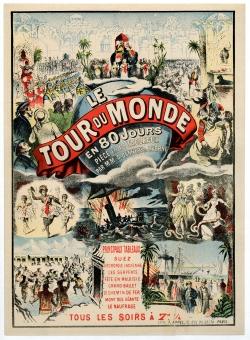
James Gurney
Night take-off
Oil on canvas, 2009
MJV C459 (Purchased from the artist, 2009)
This painting was created for the poster of the 10th international science fiction festival Les Utopiales, in tribute to Jules Verne. Around 1900, the Lépidoptère (more commonly known as Papillon) set off from place Royale in Nantes, the « Nantes Dinotopia Express ». This machine resembles those from Voyages Extraordinaires and gives a glimpse of an « ideal town », which Jules Verne, a discreet observer of the scene removed from the crowd, would no doubt not have denied,
James Gurney is known mainly for the four illustrated books in the series Dinotopia, published in 1992. Dinotopia is an imaginary island that harbours an isolated civilization where humans and dinosaurs live in harmony.
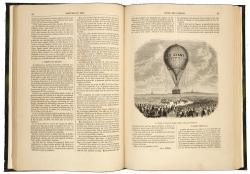
About the Giant
An article written by Jules Verne and published in Le Musée des Familles, lecture du soir (1861-1876)
MJV A5014
During the 1850s, newspapers regularly talked about the aerostation, which was a magnificent public attraction. This explains in part the role balloons would play in Jules Verne’s novels. Moreover, at a time when railways were still nascent, the aerostat was the only way to cross mountains or waterways and to reach difficult-to-access areas. The enthusiasm for the aerostation owes a great deal to Félix Tournachon, aka Nadar. A sketcher, caricature artist and photographer, he became an enthusiastic proponent of balloon travel and drew crowds with his 6,000 m3 balloon that he had built by the Godard brothers. But as Jules Verne noted in his article: « … the difficulties with his descents amply illustrated how such a massive device is dangerous to navigate and impossible to control »
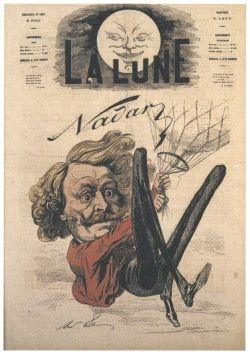
André Gill
Caricature of Nadar
published in the weekly La Lune in 1867
Reproduction, Dinard, 2000
MJV CP39
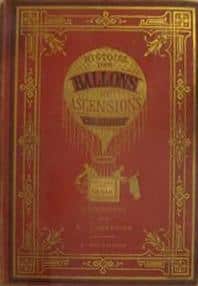
A. Sircos and Th. Pallier
Histoire des ballons et des ascensions célèbres
Paris, Roy, 1875
MJV A877
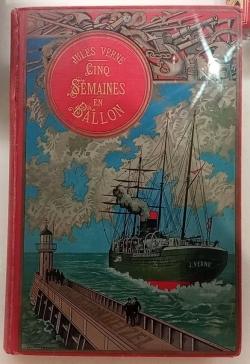
Jules Verne
Five Weeks in a Balloon, or, A Journey of Discovery by Three Englishmen in Africa
Hetzel publishing house, Paris, 1894
MJV A426
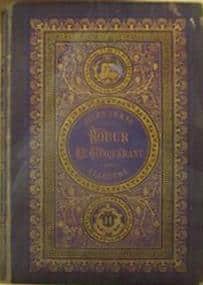
Jules Verne
Robur the Conqueror
Hetzel publishing house, Paris, 188686
MJV A3014
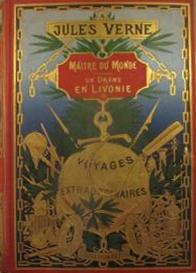
Jules Verne
Master of the World – A Drama in Livonia
Hetzel publishing house, Paris, 1904
MJV A257
In 1886, Robur the Conqueror demonstrated the dispute between the lighter (the balloons) and the heavier (the early stages of aviation) than air. Jules Verne and his hero took part in the debate and their conclusion foreshadowed what was to come: « The future of air travel lies in aircraft and not in aerostats. »

Zeppelin Fahrt: Journey by Zeppelin
Germany, circa 1900
MJV G264
The game plan shows an aerostat race in 39 boxes, plagued with annoyances and accidents. The race takes place in the skies above Germany between Karlsruhe, Stuttgart, Friedrichshafen, Konstanz, Basel and Strasbourg, then occupied.
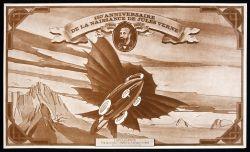
The Albatross and The Terror
Posters of the Biscuiterie Nantaise, 1978
MJV D323 and D305
These two posters were produced to commemorate the 150th anniversary of Jules Verne’s birth in 1978 by Biscuiterie Nantaise (BN), an iconic Nantes-based industrial French biscuit factory.
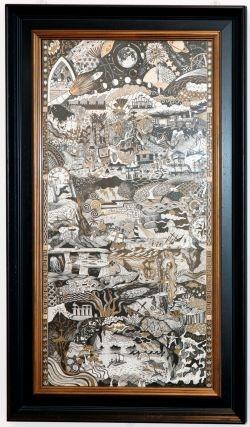
Gaëlle Compozia
To the ends of the world, illustration of the novels of Jules Verne
2019
India ink drawing and markers on Canson paper
Nantes-based artist Gaëlle Compozia creates work inspired by literature and mythology, summarising novels and myths. To the Ends of the World is a tribute to one of the central themes of Jules Verne’s body of work, namely exploration. This drawing featured five layers representing the « known and unknown worlds » of Voyages Extraordinaires, the subterranean depths and the crossing of the atmosphere. Inspired by meticulous reading of Jules Verne’s novels, but also the study of the engravings accompanying the texts and the cinematographic adaptations, the drawing was created to perfectly respect and match the texts, with an ongoing dialogue between the illustrations and the literary references.
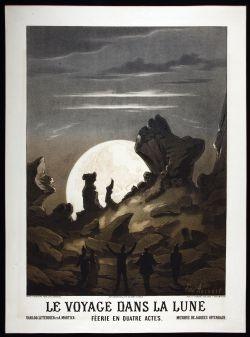
Edward Ancourt
Voyage to the Moon
Choudens Père & Fils publishing house, Paris, 1875
MJV D114
This enchanted opera in 4 acts and 23 tableaus was created at the Gaîté theatre and was inspired by Jules Verne’s moon novels. A Trip to the Moon was a hit from the outset; the public was bowled over by the impressive machinery and orchestration of Jacques Offenbach.
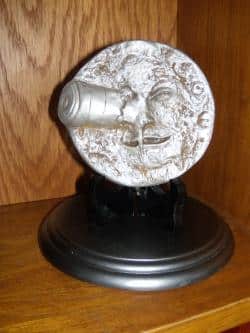
Jean-Marc Deschamps
Moon on stand
Model inspired by the film A Trip to the Moon
2000
MJV G193
A Trip to the Moon is a film produced and directed by Georges Méliès, released in 1902. It is inspired by the novels From the Earth to the Moon by Jules Verne (1865) and The First Men in the Moon by H.G. Wells.

A Trip to the Moon
Circa 1879
(donation from the Friends of the Nantes library association, 2016)
Stereoscopic view representing the enchanted opera by Jacques Offenbach, libretto by Albert Vanloo, Eugène Leterrier and Arnold Mortier according to Jules Verne, created on October 26, 1875, at the Gaîté theatre. Stereoscopy refers to the techniques used to reproduced a perception of relief based on two flat images.
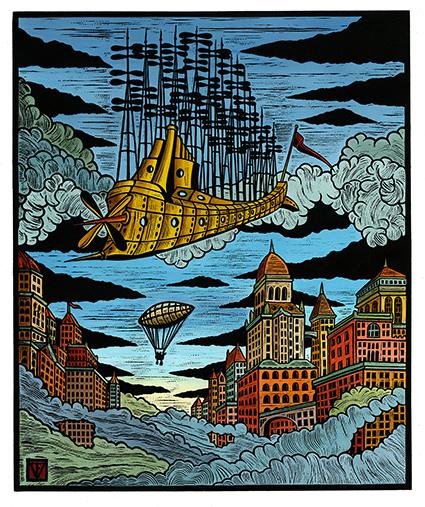
Frédéric Voisin
Robur the Conqueror
Linocut, 2020
(Purchased from the artist)
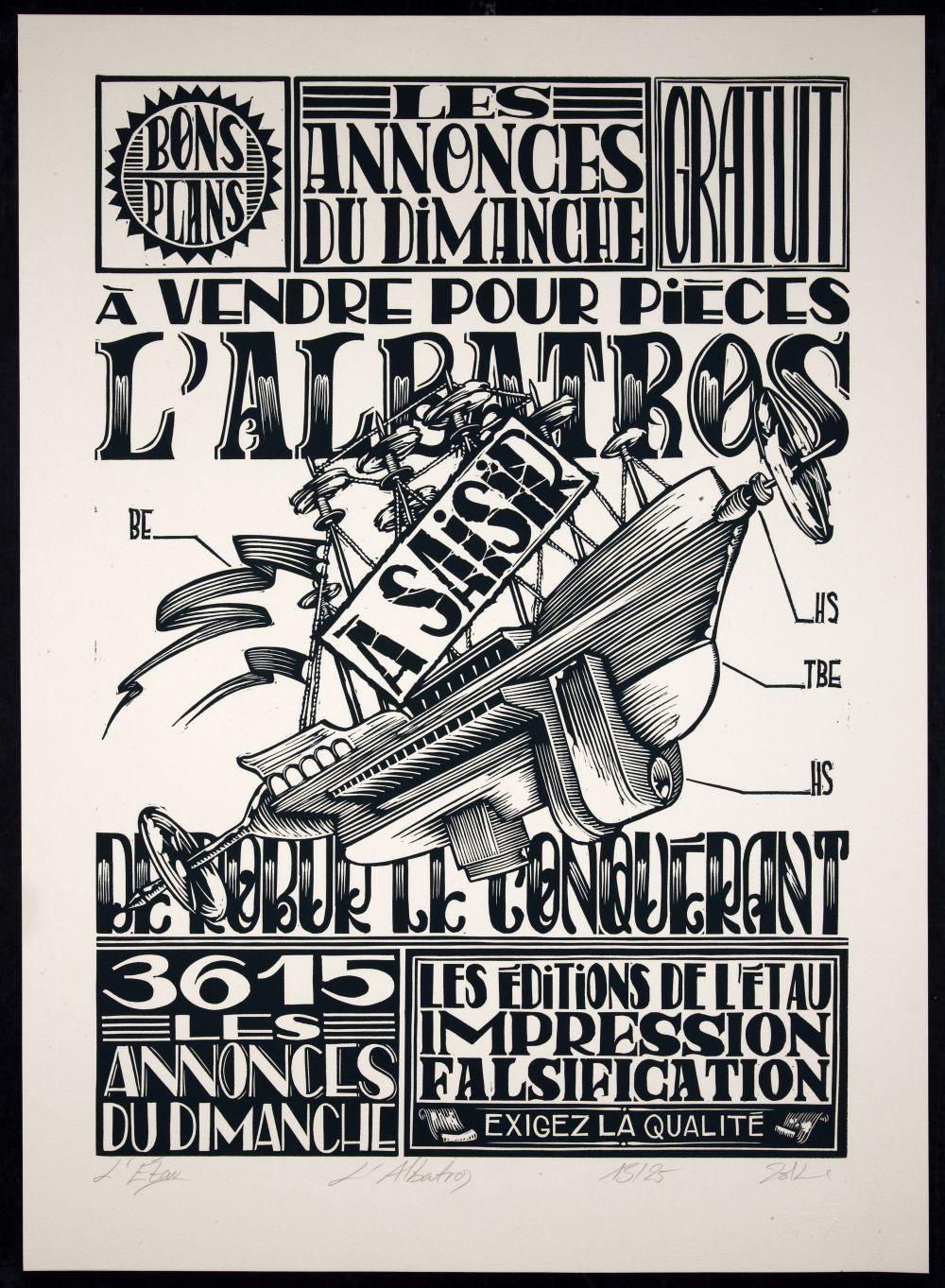
Benjamin Guyet
The Albatross
Linocut, 2014
MJV C511 (Purchased from the artist)
Benjamin Guyet dedicated a series of linocuts inspired by Jules Verne’s novels that he played up with humour and a twist, imagining new episodes such as this staging of spare parts from the flying machine The Albatross created by engineer Robur.

Scall
Spirit of owl, 2021
MJV G320 (Purchased from the artist, 2021)
This Steampunk-style model is a free interpretation of the Terror, an aircraft flown by the character Robur the Conqueror in Jules Verne’s novel Master of the World, published in 1904.
The term Steampunk was invented in 1987 by the American author Kevin Wayne Jeter. This artistic trend blends past and future in a world of adventure and technology It is based on a likely predicted future inspired by the 19th century with the codes and aesthetics from this era.
Jules Verne laid the foundations for an extrapolation of technology, which, while fulfilling its functional missions, often presents itself as a creative and decorative objet d’art.
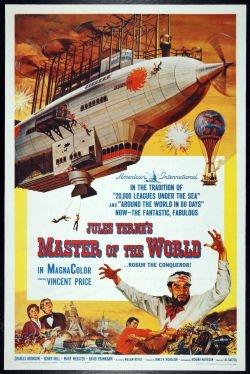
Master of the World
Poster for adaptation to the cinema
by director William Witney, 1961
MJV D290
American cinema helped promote the work of Jules Verne though the reputation of the actors, and the considerable technical and financial means employed. But what the work gained in prominence it lost in integrity: script writers changed the plots and introduced new characters.
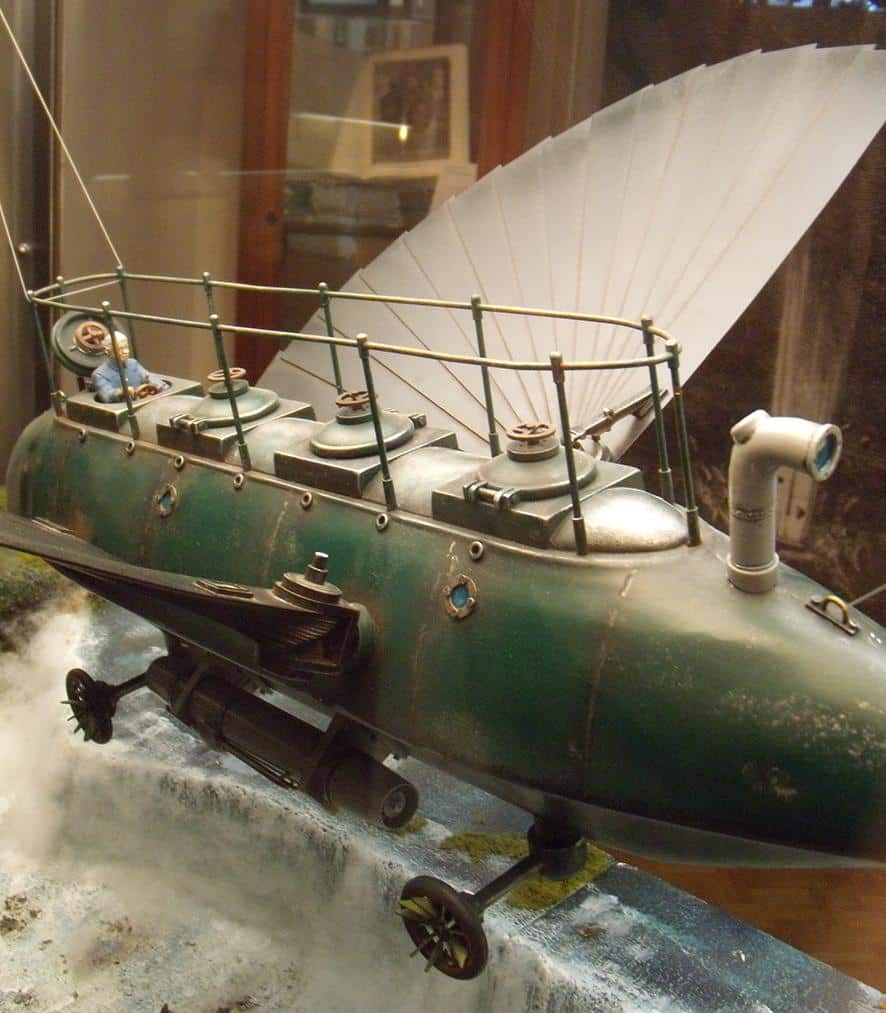
Jean-Marc Deschamp
The Terror, 2003
Model inspired by the novel Master of the World (1904)
MJVG172 (Purchased from the artist)
With Master of the World, Jules Verne completes a story begun twenty years earlier: the engineer Robur returns with a new machine and obscure projects.
The Terror is a « universal means of transport », a hybrid vehicle capable of moving on earth, on and under the water, and in the air. This curious machine takes the shape of a rocket-like aluminium structure (unlike the Albatross, Robur’s first vehicle, made from resin paper). The shell is placed on four wheels, and the spokes of the wheel widen into paddles to move faster on water. The wings are close against the sides of the vehicle; they are deployed at take-off, then start to flap like the wings of a bird. 10 metres long, 1.80 metres wide, the Terror exceeds 250 km/hour on land thanks to Parsons turbines placed each side of the which propel the vehicle in water and on land.
The Terror and its creator met a tragic end: they defied the elements and were struck by a vengeful lighting bolt and swallowed up in the depths of the Gulf of Mexico.
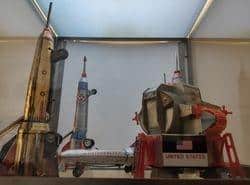
Selection of toys: The conquest of space
(André Martin collection)
With his stories From the Earth to the Moon (1865) and Around the Moon (1869) which describe propulsion and the orbiting around the Moon of a manned space craft, Jules Verne foretold the exploits of space programmes a century in advance. He can be considered as « one of the greatest pioneers of the space age » (Frank Borman, astronaut).
These objects illustrate the conquest of space and the race to the Moon undertaken by the united States and the USSR after the Second World War. Within the Cold War context, the launch of the artificial satellite Sputnik 1 and the first flight in space made by Youri Gagarine, demonstrated the dominance of the Soviets in this area. This rivalry led the United States to launch the Apollo programme with the aim of taking a man to the Moon. This ambitious project became reality on July 21, 1969, with the Apollo mission and the first steps on the moon by Neil Armstrong and Buzz Aldrin.

Jame’s Prunier
Around the Moon
Gouache and watercolour on paper
MJV C355 (acquired with support from the Pays de la Loire region)
Original drawings for an edition of Jules Verne’s novel published by Gallimard in 2004.
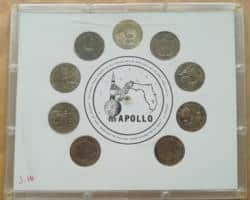
Set of 9 commemorative medals from the Apollo 7 to 15 missions
Circa 1971
MJV G319
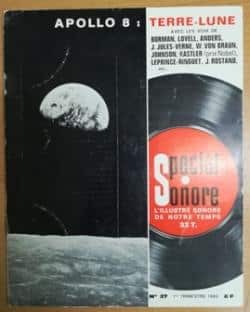
L’Illustré sonore de notre temps. Apollo 8: Terre-Lune (Frank Borman)
1969
MJV F249
This flexible disk contains audio archives from NASA taken from the Houston space centre and recorded during the Apollo 8 mission from December 21 to 27, 1968. The voices recorded are those of astronauts Frank Borman, James Lovell and William Anders. The Apollo programme, the NASA space programme conducted from 1961 to 1975, was launched by US President John F. Kennedy in response to the successes of the Russian space programme. The goal: to place a man on the moon. On July 21, 1969, two of the three members of the Apollo 11 mission crew, Neil Armstrong and Buzz Aldrin, accomplished the mission.
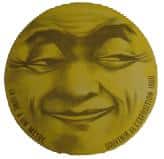
The Astronomer’s Dream, souvenir from the 1900 World’s Fair
MJV G249
At the 1900 Paris World’s Fair, a scientific attraction entitled The Astronomer’s Dream, a reference to the 1898 film of Georges Méliès, combined the resources of a gigantic astronomer’s telescope (60m long) and a photographic system, offering the public a version of the Moon many kilometres away.
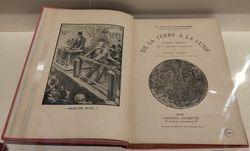
Jules Verne
From the Earth to the Moon: Direct in 97 Hours, 20 Minutes
Hetzel publishing house, Paris, 1895
MJV A429
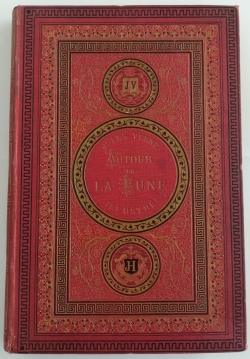
Jules Verne
Around the Moon
Hetzel publishing house, 1875-1890
MJV A362
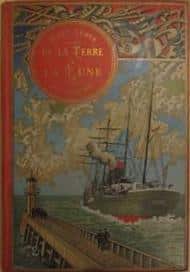
Jules Verne
From the Earth to the Moon: Direct in 97 Hours, 20 Minutes
Hetzel publishing house, 1895
MJV A455
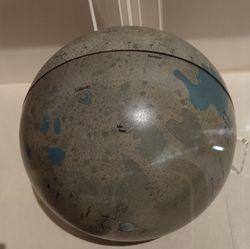
Moon Globe
Richard M. Grossman and his team of mappers
Adler Planetarium and Astronomical Museum, Chicago, 1966
(André Martin collection)
The Jules Verne crater was named for the author on a decision by the International Astronomical Union in 1961. Located on the hidden side of the moon, it is 143 kilometres in diameter and its depth is unknown. The crater is covered in basalt lava and its edge, worn by erosion, show seven small satellite craters. They were given the same name, followed by an additional upper case letter: « Jules Verne G » or « Jules Verne Z ».
